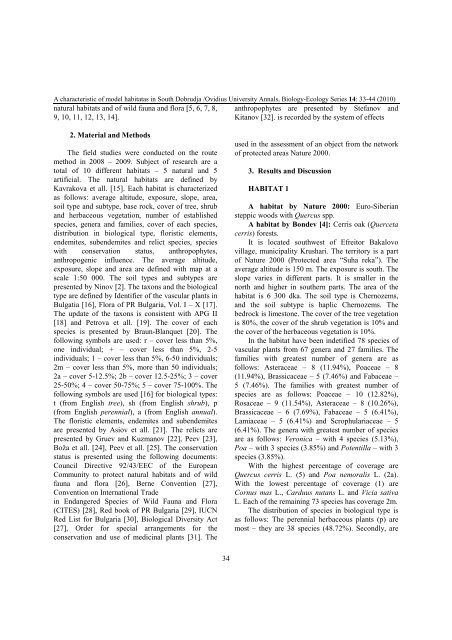VOLUM OMAGIAL - Facultatea de Ştiinţe ale Naturii şi Ştiinţe Agricole
VOLUM OMAGIAL - Facultatea de Ştiinţe ale Naturii şi Ştiinţe Agricole
VOLUM OMAGIAL - Facultatea de Ştiinţe ale Naturii şi Ştiinţe Agricole
Create successful ePaper yourself
Turn your PDF publications into a flip-book with our unique Google optimized e-Paper software.
A characteristic of mo<strong>de</strong>l habitatas in South Dobrudja /Ovidius University Annals, Biology-Ecology Series 14: 33-44 (2010)<br />
natural habitats and of wild fauna and flora [5, 6, 7, 8,<br />
9, 10, 11, 12, 13, 14].<br />
2. Material and Methods<br />
The field studies were conducted on the route<br />
method in 2008 – 2009. Subject of research are a<br />
total of 10 different habitats – 5 natural and 5<br />
artificial. The natural habitats are <strong>de</strong>fined by<br />
Kavrakova et all. [15]. Each habitat is characterized<br />
as follows: average altitu<strong>de</strong>, exposure, slope, area,<br />
soil type and subtype, base rock, cover of tree, shrub<br />
and herbaceous vegetation, number of established<br />
species, genera and families, cover of each species,<br />
distribution in biological type, floristic elements,<br />
en<strong>de</strong>mites, suben<strong>de</strong>mites and relict species, species<br />
with conservation status, anthropophytes,<br />
anthropogenic influence. The average altitu<strong>de</strong>,<br />
exposure, slope and area are <strong>de</strong>fined with map at a<br />
sc<strong>ale</strong> 1:50 000. The soil types and subtypes are<br />
presented by Ninov [2]. The taxons and the biological<br />
type are <strong>de</strong>fined by I<strong>de</strong>ntifier of the vascular plants in<br />
Bulgatia [16], Flora of PR Bulgaria, Vol. І – Х [17].<br />
The update of the taxons is consistent with APG II<br />
[18] and Petrova et all. [19]. The cover of each<br />
species is presented by Braun-Blanquet [20]. The<br />
following symbols are used: r – cover less than 5%,<br />
one individual; + – cover less than 5%, 2-5<br />
individuals; 1 – cover less than 5%, 6-50 individuals;<br />
2m – cover less than 5%, more than 50 individuals;<br />
2a – cover 5-12.5%; 2b – cover 12.5-25%; 3 – cover<br />
25-50%; 4 – cover 50-75%; 5 – cover 75-100%. The<br />
following symbols are used [16] for biological types:<br />
t (from English tree), sh (from English shrub), p<br />
(from English perennial), а (from English annual).<br />
The floristic elements, en<strong>de</strong>mites and suben<strong>de</strong>mites<br />
are presented by Asiov et all. [21]. The relicts are<br />
presented by Gruev and Kuzmanov [22], Peev [23],<br />
Boža et all. [24], Peev et all. [25]. The conservation<br />
status is presented using the following documents:<br />
Council Directive 92/43/EEC of the European<br />
Community to protect natural habitats and of wild<br />
fauna and flora [26], Berne Convention [27],<br />
Convention on International Tra<strong>de</strong><br />
in Endangered Species of Wild Fauna and Flora<br />
(CITES) [28], Red book of PR Bulgaria [29], IUCN<br />
Red List for Bulgaria [30], Biological Diversity Act<br />
[27], Or<strong>de</strong>r for special arrangements for the<br />
conservation and use of medicinal plants [31]. The<br />
34<br />
anthropophytes are presented by Stefanov and<br />
Kitanov [32]. is recor<strong>de</strong>d by the system of effects<br />
used in the assessment of an object from the network<br />
of protected areas Nature 2000.<br />
3. Results and Discussion<br />
HABITAT 1<br />
A habitat by Nature 2000: Euro-Siberian<br />
steppic woods with Quercus spp.<br />
A habitat by Bon<strong>de</strong>v [4]: Cerris oak (Querceta<br />
cerris) forests.<br />
It is located southwest of Efreitor Bakalovo<br />
village, municipality Krushari. The territory is a part<br />
of Nature 2000 (Protected area “Suha reka”). The<br />
average altitu<strong>de</strong> is 150 m. The exposure is south. The<br />
slope varies in different parts. It is smaller in the<br />
north and higher in southern parts. The area of the<br />
habitat is 6 300 dka. The soil type is Chernozems,<br />
and the soil subtype is haplic Chernozems. The<br />
bedrock is limestone. The cover of the tree vegetation<br />
is 80%, the cover of the shrub vegetation is 10% and<br />
the cover of the herbaceous vegetation is 10%.<br />
In the habitat have been in<strong>de</strong>tified 78 species of<br />
vascular plants from 67 genera and 27 families. The<br />
families with greatest number of genera are as<br />
follows: Asteraceae – 8 (11.94%), Poaceae – 8<br />
(11.94%), Brassicaceae – 5 (7.46%) and Fabaceae –<br />
5 (7.46%). The families with greatest number of<br />
species are as follows: Poaceae – 10 (12.82%),<br />
Rosaceae – 9 (11.54%), Asteraceae – 8 (10.26%),<br />
Brassicaceae – 6 (7.69%), Fabaceae – 5 (6.41%),<br />
Lamiaceae – 5 (6.41%) and Scrophulariaceae – 5<br />
(6.41%). The genera with greatest number of species<br />
are as follows: Veronica – with 4 species (5.13%),<br />
Poa – with 3 species (3.85%) and Potentilla – with 3<br />
species (3.85%).<br />
With the highest percentage of coverage are<br />
Quercus cerris L. (5) and Poa nemoralis L. (2a).<br />
With the lowest percentage of coverage (1) are<br />
Cornus mas L., Carduus nutans L. and Vicia sativa<br />
L. Each of the remaining 73 species has coverage 2m.<br />
The distribution of species in biological type is<br />
as follows: The perennial herbaceous plants (p) are<br />
most – they are 38 species (48.72%). Secondly, are





